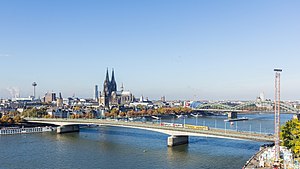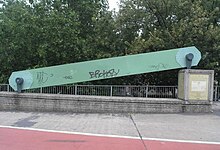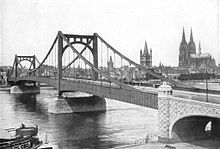Deutz Bridge
Coordinates: 50 ° 56 ′ 11 ″ N , 6 ° 57 ′ 57 ″ E
| Deutz Bridge | ||
|---|---|---|
| View of the Deutzer Bridge from Deutz towards the old town / Cologne Cathedral | ||
| use | Street | |
| Subjugated | Rhine | |
| place | Cologne - Altstadt-Nord - Cologne- Deutz | |
| overall length | 437 meters | |
| width | 31.50 meters | |
| Longest span | 184 meters | |
| location | ||
|
|
||
The Deutzer Brücke in Cologne is a bridge over the Rhine . It connects Cologne's inner city ( Heumarkt ) with the Cologne-Deutz district on the right bank of the Rhine and is used for light rail and car traffic.
Roman bridge 310 to approx. 950
The first Rhine crossing at this point was built around 310 by the Romans under Constantine with a wooden structure on stone river pillars . This Rhine bridge was a trestle or yoke bridge that was supported by 19 stone post foundations. These piles for the stone foundations in the river consisted of around 150 oak piles that were driven deep into the bed of the Rhine. Above it sat rectangular pillars with a triangular point made of ashlar masonry facing upstream. They carried the wooden superstructure with the approximately eleven meter wide roadway. Their location was on today's Salzgasse near Groß St. Martin over the Roman port. It ran over the then still existing Rhine island in an easterly direction to the west gate of the new Deutz fort (next to the former Lufthansa high-rise ). It is reported that the demolition of the bridge was initiated by Archbishop Bruno (953-965) after the maintenance of the wooden parts had long been neglected. This can only refer to the remains of the pillars that were obstacles to navigation. Because after Constantine's death (337) there is no mention of this crossing of the Rhine, so that from this point on it can be assumed that it will decay relatively quickly. In 1898, wooden pile remains of this bridge were removed from the bed of the Rhine.
Yaw ferry
Since approx. In 1670 Cologne was connected to the other side of the Rhine by a "flying bridge" (also called " Gierponte ").
Ship bridge 1822
On November 16, 1822, a 400 m long wooden ship bridge carried by around 40 boats was inaugurated. It enabled a permanent connection between Cologne and Deutz in the amount of the wood market and the Deutz freedom. However, floods, drift ice and the need to open the bridge to shipping three times a day continued to affect smooth traffic. The middle part of the bridge had to be floated to open the bridge to shipping.
The Cologne fought for the position for the planned cathedral bridge , a combined road and rail bridge. But they could not prevail, so that since 1859 the ship (s) bridge and the new "fixed bridge" existed side by side.
Suspension bridge 1913–1945
From 1913 to 1915, the "Deutz Suspension Bridge" was built then at this point that after the late last year the President 1935 Paul von Hindenburg Hindenburg Bridge was called.
A first competition for a fixed road bridge between Cologne and Deutz was held in 1898 among four construction companies, but it did not lead to any result. In 1910 there was another tender, in which all the major German steel construction companies - mostly in cooperation with well-known architects such as Bruno Möhring , Theodor Fischer , Hans Poelzig or Franz Schwechten - took part with 29 projects. As the jury was again unable to agree on a winning project, another competition was announced in July 1912 among the authors of the five award-winning works, which the companies MAN Werk Gustavsburg (steel superstructure) and Grün & Bilfinger (substructure) with the project Free Path for could decide. The architectural design of the massive components (abutment and front bridge) was done by the then prominent Cologne architect Carl Moritz .
After the competition decision, the Deutsch-Luxemburgische Bergwerks- und Hütten-AG , Dept. Dortmunder Union , and their artistic advisor Peter Behrens accused that the winning project was largely a plagiarism of their own design Art and Technology from the second competition in 1910 / 11. Subsequent legal proceedings with the participation of numerous well-known experts before the Cologne Regional Court, which received nationwide attention as the Cölner bridge dispute. was only ended in April 1914 by an out-of-court settlement.
The structure built on the basis of the Free Path design was designed as a self-anchored, stiffened chain suspension bridge in nickel steel with a construction weight of around 6,200 tons and cost over 7 million marks . The American engineer Holton D. Robinson is said to have assisted in the design of their pylons , who later invited David B. Steinman to found the engineering firm Robinson & Steinman with him. The Deutz suspension bridge served as a model for the construction of the Three Sisters in Pittsburgh , Pennsylvania , and for the Kiyosu Bridge over the Sumida (river) in Tokyo in 1924 . The 18.20 m wide bridge was widened to 27.50 m in 1939/1940 as part of the construction of Ost-West-Straße (today Hahnenstraße / Cäcilienstraße ).
On February 28, 1945, the Hindenburg Bridge, which was heavily burdened by refugees and military vehicles, collapsed while repairing war damage. It is possible that the high compressive forces in the pavement beam had been underestimated. How many victims this accident claimed in broad daylight could never be determined due to the chaos of war. An eye stick , one of the main chain links of the construction, is now a memorial on the northern pedestrian crossing on the left bank of the bridge.
New building 1947/1948
The current bridge structure was rebuilt only two years later, from 1947 to 1948. The world's first steel box girder bridge was designed by Fritz Leonhardt and built by GHH Oberhausen AG. The Cologne architect Gerd Lohmer was an artistic advisor. The new Deutz Bridge was inaugurated on October 16, 1948, painted in Cologne's bridge green.
With a total length of 437 meters, it has spans of 132, 184 and 121 meters and a width of 20.60 meters. The lower chord of the longitudinal girders is curved so that the height of the superstructure above the pillars is 7.8 meters and in the middle of the main opening is only 3.3 meters.
Expansion from 1976 to 1980

Between 1976 and 1980 a second bridge with the same profile, but as a prestressed concrete structure , was built and connected to the old bridge in such a way that the tram was given its own double-track track between the lanes. The width of the combined bridges was now 31.50 m.
The decision for a prestressed concrete bridge was very controversial among the competing applicants, steel construction companies versus concrete construction companies. The decisive factor was the result of the submission with an offer of 12 million DM for the prestressed concrete bridge and 14 million DM for the steel structure. The externally visible web surface was structured with vertical ribs and a flange attached at the bottom to give the bridge an appearance similar to the steel construction. The massive bridge was built upstream next to the existing bridge and was only pushed towards the steel bridge after completion in an action that took several days.
As the only Rhine bridge in Cologne , the extension of the Deutz Bridge is not painted green due to the lack of use for the durability of the concrete.
Since the reinforced concrete box with a rectangular cross-section does not contain any fixtures, it forms three accessible rooms (without daylight) with curved floors and varying room heights. These rooms are repeatedly used for art installations, exhibitions at the furniture fair and for concerts.
Art actions
"Over / mn / flow"
The art project “über / mn / fluss” was initiated in 2003 under the motto “tension in the prestressed concrete structure of the Deutz Bridge”. Young artists from numerous nations (including Germany, Denmark, Argentina, Belarus, Scotland, Japan, Iceland) from the most varied of disciplines (including musicians, visual artists, architects, filmmakers ...) take part.
In March 2007, the concrete body of the Deutz bridge served for the third time after “spaen” (2003) and “Dudeldack” (2005) as a backdrop for the installation art project “über / mn / fluss”. The works of the two filmmakers Beate Gördes and Bea Dickas created during the art event offer an insight into the character of the room.
Subculinaria

In August 2008 the exhibition Subkulinaria took place with international artists . The entire cavity of the bridge was played on from one side of the bank to the other and made accessible to visitors.
Bridge music
BRÜCKENMUSIK, established by Peter Behrendsen in 1995, is an annual series for sound installations and acoustic art in the hollow concrete body of the bridge.
Web links
Individual evidence
- ^ Franz Bender: Illustrated history of the city of Cologne . Verlag Bachem, Cologne 1924, p. 21
- ↑ a b Roland May: Discovering Construction as an Art - The 'Cologne Bridge Quarrel' (PDF). In: Karl-Eugen Kurrer , Werner Lorenz , Volker Wetzk (eds.): Proceedings of the Third International Congress on Construction History. Neunplus, Berlin 2009, ISBN 978-3-936033-31-1 , pp. 1011-1018.
- ↑ HAER Report No. PA-490 via the Three Sisters (Pittsburgh) ( page no longer available , search in web archives ) Info: The link was automatically marked as defective. Please check the link according to the instructions and then remove this notice. , P. 29 below, in the Historic American Engineering Record
- ^ Sixth, Seventh, and Ninth Street Bridges over the Allegheny River , HAER-Report No. PA-490 via the Three Sisters (Pittsburgh) ( page no longer available , search in web archives ) Info: The link was automatically marked as defective. Please check the link according to the instructions and then remove this notice. , P. 24 f, in the Historic American Engineering Record
- ↑ Detlef Knop, Joachim Urban: New, freely pre-built prestressed concrete bridges over the Rhine in Cologne-Deutz, Konstanz and Weil . In: Beton- und Stahlbetonbau , 75th year, 1980, issue 7, pp. 153–160
- ↑ The Cologne Bridge Green. Retrieved November 12, 2018 .
- ↑ bridge music, homepage. Retrieved July 9, 2018 .
|
The next bridge upstream: Severinsbrücke |
Bridges over the Rhine |
The next bridge down the river: Hohenzollern Bridge |







